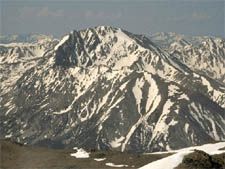



Summary of Cenozoic Elevation in the American West
So what exactly do the southern Rockies tell us about the Cenozoic evolution of the western United States? Until recently, the presence of the extensive Late Eocene erosion surface in south-central Colorado and the low-elevation interpretation of the Florissant flora lent support to the hypothesis that a large portion of the west underwent rapid regional uplift in last 10-5 m.y. These interpretations matched well with what others had found through the western U.S., and so the story of recent uplift remained mostly unchallenged for a few decades (see references in Christiansen and Years, 1992). New studies still lend support to the recent uplift hypothesis (eg., McMillian et al., 2002), but the doubters are growing louder and more persistent.
Challenges to the idea of Late Cenozoic uplift comes from a number of directions. Skepticism regarding the "nearest living relative" paleobotanical method led to new methods and new interpretations of the classic Florissant flora, as well as additional data from other fossil flora through the western United States (e.g., Wolfe et al., 1998). When the subjectivity of floral classification is replaced by physiognomic measurements and statistical analysis, and when broad inferences from mean annual temperatures are reconsidered in terms of atmospheric physics, the fossil plants seem to suggest Eocene and Oligocene altitudes at least as high as, if not higher than, present altitudes. However, while the quantitative physiognomic and thermodynamic methods clearly provide better paleobotanical analyses than the old floristic standard, the methods are not foolproof and a number of questions still remain as to how reliable the high-altitude inferences actually are.
Results from studies in the Sierra Nevada (Small and Anderson, 1995), the Basin and Range (Wolfe et al., 1997), the Rockies of Wyoming (Small and Anderson, 1998) have also called into question the hypothesis of widespread rapid Late Cenozoic uplift due to some mysterious tectonic cause. On the one hand, moving the uplift event back tens of millions of years solves the problem of mechanism, for no research has yet identified any tectonic event in the last 10-5 m.y. that can reasonably explain Late Cenozoic uplift. If elevations were already high by the Eocene, however, there are recognized tectonic events available to explain the elevations (e.g., Laramide orogeny, formation of the Sierra Nevada, etc.).
On the other hand, if Late Cenozoic uplift did not occur, some other event must have caused the widespread erosion and incision unmistakably evidenced throughout the western U.S. Molnar and England (1990) suggest that climate, rather than tectonics, could be responsible for the dramatic increase in sedimentation and landscape incision seen in the last 5 m.y. both in the western United States and throughout the world. Both hypotheses are difficult to prove or disprove, however, because however likely or unlikely each explanation might seem, it remains quite challenging to distinguish a climate signal from a tectonic signal. Thus it is increasingly important to develop methods of accurately determining paleoaltitudes and answering the uplift-related questions: how fast and how high?